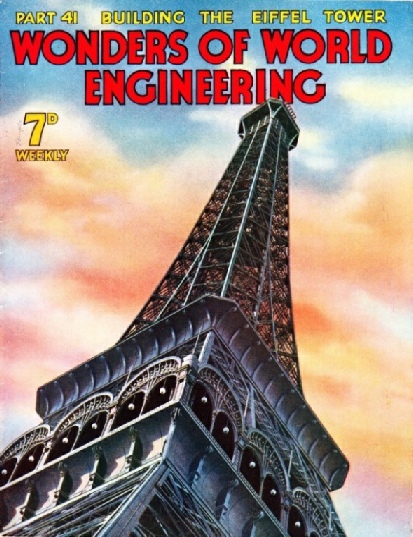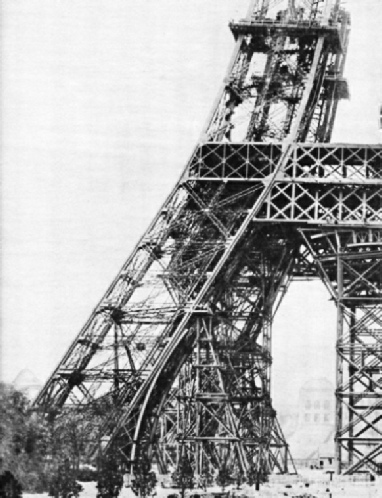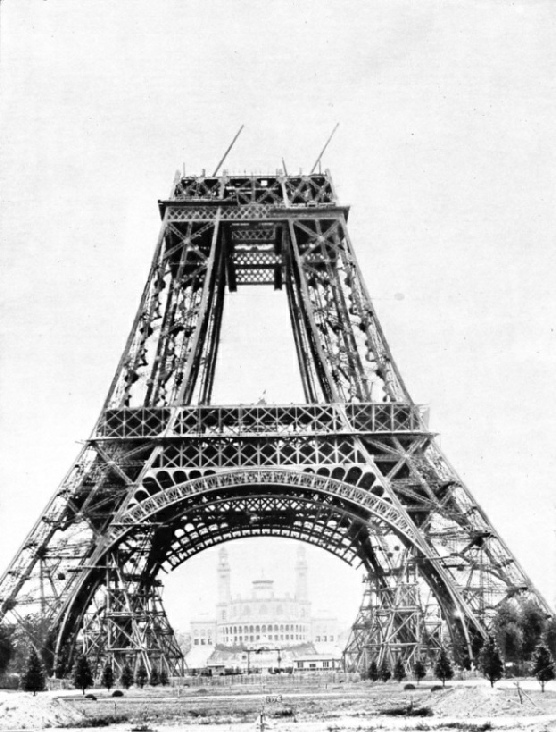

© Wonders of World Engineering 2014-




Part 41
Part 41 of Wonders of World Engineering was published on Tuesday 7th December 1937, price 7d.
Part 41 includes a photogravure supplement showing the construction of the Eiffel Tower. This section illustrates the article on The Eiffel Tower.
The Cover
The cover of this week’s Part shows the upper portion of the Eiffel Tower. This striking photograph is reproduced in the photogravure section on page 1173.

Contents of Part 41
Military Engineering (Part 2)
This chapter on military engineering covers every activity of the Royal Engineers. The article is concluded from part 40.
Oil Engine Construction
Despite the enormous variety in size and power of oil engines used to-day on land and sea, the manufacturing processes are generally the same, although they differ slightly in detail according to each maker’s standard practice. The applications of the oil engine on land and on sea are almost universal. Oil engines are yearly playing an increasingly predominant part in road and railway transport, and it is a remarkable fact that nearly two-thirds of all the marine engines under construction at the present moment are oil-driven. A description of the building of an oil engine helps in the understanding of the principle on which it works. This chapter describes oil engines and their construction.
You can read more on diesel engines in Railway Wonders of the World and in
Shipping Wonders of the World.
The Eiffel Tower
The work of a brilliant and imaginative French engineer, the Eiffel Tower stands to-day a predominant landmark of Paris, towering nearly 1,000 feet above the banks of the Seine. The story of its conception and construction is unique in the history of engineering. Although it can claim no longer to be the highest structure built by man, it stands unique as a pinnacle of engineering in the nineteenth century. The romantic story of the building of the Eiffel Tower is described in this chapter which is illustrated by some remarkable photographs, including a section in photogravure, of the Eiffel Tower in course of construction.
The Eiffel Tower (photogravure supplement)
The Eiffel Tower
Photogravure Supplement - 2
FROM THE GROUND TO THE FIRST PLATFORM proved the most difficult and dangerous section in the building of the Eiffel Tower. Although Eiffel had contrived to build many of his great bridges without the aid of centering, the weight and inclination of the box girders made it necessary for them to be temporarily supported by triangulated wooden columns. When the four great legs, however, had been united by the massive horizontal girders of the first platform, the whole formed a strong, rigid base for the rest of the tower.
Contents of Part 41 (continued)
Origin of the Locomotive
The steam railway locomotive’s history began in 1804. In that year Richard Trevithick demonstrated the capabilities of a railway engine in South Wales. John Blenkinsop’s engine began to run in 1812. Of the other pioneers the most famous was George Stephenson, whose Rocket of 1829 gained world renown. This chapter describes the developments which early locomotive engineers quickly produced as the demand for steam-driven transport began to grow. This is the fifth article in the series on Invention and Development.
You can read more on early locomotive design and development in
Railway Wonders of the World.
Windmills and Their Story (Part 1)
The power of the wind is one of the forces of nature that man from time immemorial has harnessed in various ways. Modern developments from the various types of windmill are used for driving ships, for pumping water and for generating electricity. At one time windmills, of which there are many varieties, were an important feature of life in Great Britain and in the Low Countries, as well as in other parts of the world. This chapter is concluded in part 42.
The Eiffel Tower
Photogravure Supplement - 3
THE COMPLETED BASE of the Eiffel Tower formed a rigid support for the remaining portion of the tower. The level of the first platform is 189 feet above the ground. The four legs continue to converge until they meet the second platform, at a level of 379 feet. Lifts run up to this platform along inclined shafts in all four legs.
The Eiffel Tower
Photogravure Supplement
A FAMOUS PARISIAN LANDMARK, the Eiffel Tower was designed and built for the great Paris Exhibition of 1889 by Alexandre Gustave Eiffel, an enterprising and brilliant engineer. The structure is 984 feet high, and is situated in the Champ de mars, beside the River Seine. This photograph shows the upper section of the tower and the second intermediate platform, 379 feet above the ground. In planning the ironwork, 12,000 working scale drawings were required.
This photograph was also used on the cover of this part.



